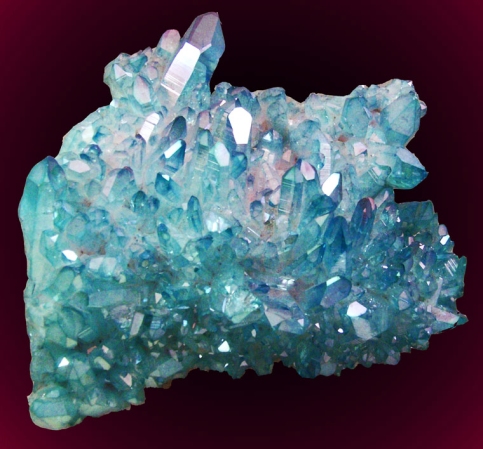Over the last decade or so, there has been a massive resurgence in the interest in crystals for healing and metaphysical uses, this has led to huge demand for crystals. Where a demand exists, the belief is that supply must meet this demand. Crystals however are a finite resource, this has led some unscrupulous suppliers to artificially create quartz varieties in high demand or sell other crystal varieties as quartzes.
Below are some examples of the more common fakes that I have come across.
Purple Fluorite sold as Amethyst
Purple fluorite in its natural form forms cubic crystals.

Many raw crystals and minerals are cut into crystal points. When purple fluoride is cut in crystal points like this one, they can resemble chevron amethyst. Side by side you can see that the white inclusions in fluorite form parallel lines (due to its internal cubic structure) whereas the white inclusions in chevron amethyst are random and angled. This is because amethyst has a trigonal crystal system, i.e. it forms angular crystals.
Probably the simplest way to spot fake amethyst is to check its hardness. All quartz has a hardness of 7 on the hardness scale devised by Friedrich Mohs[1]. Thus quartz cannot be scratched by a knife. If you scratch your “amethyst” crystal point with a knife and it is damaged by a knife blade, it has a hardness of less than 5 ½ , in fact it is a prime indicator that it is actually fluorite which has a hardness of 4.
[1] Under the Moh’s hardness scale, your fingernail has a hardness of 2 ½ ,coins 3 ½ , a knife blade is 5 ½ , glass is 6, quartz is 7, diamond is 10
Heat Treated Amethyst Sold As Citrine
Amethyst is formed when iron-rich (Fe3+) quartz is exposed to Gamma Rays and is oxidized to Fe4+. When amethyst is exposed to heat of between 450 to 600°C over a sustained period of time Citrine is formed. The in-between stage between amethyst and citrine is ametrine:

When this conversion from amethyst, through ametrine to citrine occurs naturally, the citrine crystals are pale in colour, they have yellow champagne, pale brown (weak tea colour) or pale orange hues:

Because natural citrine (image courtesy of http://www.pixiecrystals.com) is quite rare, it has become practice in some circles to artificially create citrine by “cooking” amethyst in furnaces, sometimes even right at the mine from where it is sourced. This heat treated amethyst is then sold as citrine to the unsuspecting public.
This man-made citrine is always bright and sometimes opaque in colour. These dark orange-brown crystals are an easy way to spot “fake” citrine.

Artificially created Green Quartz sold as Prasiolite / Vermarine
Vermarine, also known as Prasiolite is a naturally occurring green quartz. In its natural form it is olive green or pale yellow-green in colour. Natural Prasiolite is sourced from Thunder Bay in Canada, along with a few other sides in the Northern Hemisphere.
The Vermarine from Thunder Bay was formed when an amethyst deposit was overrun by a basalt flow. The combination of the heating and the presence of un-bonded iron in the magma resulted in the formation of Prasiolite. The colour of Prasiolite[1] is due to the presence of Fe2+.

[1] Image source: http://minerals.gps.caltech.edu/Mineral_Pictures/Green_Quartz_HVD120448.jpg
Natural vermarine / pasiolite is rare and expensive, as a result it is being synthetically created by a subjecting amethyst to a combination of heat and ionizing treatment radiation (Be2+ is used as catalyst for more Fe2+ to be taken up). These synthetically created pasiolite samples are easily recognised by their vivid green colour. The following is an example of artificially created green quartz:

Aqua Aura Quartz

Contrary to what is widely believed these crystals are fully synthetic. They do not occur in nature. Aqua aura is formed when fine vaporised gold is bonded to clear quartz crystals.
Many believe that these crystals are very powerful healing stones cleansing and healing your auric field, this is due largely to the presence of gold which covers the stone, combining with the high vibration of the quartz. Personally, I am more of a purist, in that I prefer to work with naturally occurring crystals…
References:
- (2016). Quartz and its coloured varieties [online]. Available at: http://minerals.gps.caltech.edu/ge114/Lecture_Topics/Quartz/Index.htm [Accessed 15 Aug 2016].
- Eason, C. (2015). The Complete Crystal Bible – 500 crystals to heal your body, mind and spirit. London, Carlton Books.
- Gemdat (2016). Prasiolite [online]. Available at: http://www.gemdat.org/gem-40112.html [Accessed 16 Aug 2016].
- The Quartz Page (2011). Prasiolite [online]. Available at: http://www.quartzpage.de/prasiolite.html [Accessed 16 Aug 2016].



You have used one of my photographs. Link please to http://www.pixiecrystals.com – on the NATURAL CITRINE CLUSTER. THANKS. Loren. http://www.pixiecrystals.com
LikeLiked by 1 person
Hi Loren, the article has been updated with the image credit.
LikeLike